Top 17 Project Management Methodologies (+ Examples)

Sorry, there were no results found for “”
Sorry, there were no results found for “”
Sorry, there were no results found for “”

There’s no doubt about it, project management can be hard sometimes and not every project sees the light of day.
Most projects fail not because teams lack talent, but because they lack structure. Without a clear methodology, priorities shift daily, responsibilities blur, and deadlines slip.
But it doesn’t have to be this way. The right framework turns uncertainty into progress. This guide walks through 17 methodologies with real examples so you can pick the approach that fits your project.
A project management methodology is a structured framework that defines how you plan, execute, and complete projects. It establishes the processes, tools, and communication patterns your team follows from kickoff to delivery.
Think of it as your project’s operating system. It determines how you handle changing requirements, when stakeholders review progress, how you allocate resources and manage risk, and what documentation you maintain throughout the project management life cycle.
Different projects need different approaches, as one method doesn’t fit all use cases.
For example, the construction industry typically uses sequential methods because you cannot install windows before framing walls. On the other hand, software teams often prefer iterative approaches because user feedback shapes the product.
Your methodology should match your project constraints, not the other way around.
Choosing the right methodology can be the difference between a project that thrives and one that stalls.
The table below compares the most popular approaches so you can quickly identify which framework matches your project type, team size, and tolerance for change.
| Methodology | Project Type | Change Tolerance | Team Size | Primary Strength |
|---|---|---|---|---|
| Waterfall | Construction, Manufacturing | Low | Any | Predictable timeline |
| Agile | Software, Marketing | High | 3-15 | Fast adaptation |
| Scrum | Complex software | High | 5-9 | Team coordination |
| Kanban | Ongoing operations | Very High | Any | Flow visibility |
| Lean | Process improvement | Medium | Any | Waste elimination |
| Six Sigma | Quality control | Low | 10+ | Defect reduction |
| PRINCE2 | Large organizations | Low | 20+ | Governance structure |
Now let’s review each option in detail and discuss pros, cons, and when each should be used.
Waterfall follows a linear sequence where each phase completes before the next begins. You gather requirements, design the solution, build it, test it, then deploy. Once you finish a phase, returning to it costs significant time and money.

Construction and manufacturing projects with physical deliverables fit Waterfall because you cannot change a poured foundation without major expense. Projects with regulatory requirements also benefit from the documentation and formal approvals at each gate.
The methodology provides three key advantages:
Waterfall does not adapt easily to changing requirements. If customers request changes mid-project or initial requirements were misinterpreted, revisiting prior phases becomes expensive and time-consuming.
The rigid structure that provides predictability also limits flexibility when you discover new information.
Boeing’s development of the 777 aircraft is a textbook example of the Waterfall methodology in action. Spanning 1986 to 1995, the project followed a traditional, linear approach, progressing through well-defined phases with minimal iteration.
Its hierarchical organization mirrored the aircraft’s physical components, such as wings and fuselage, while cross-functional design-build teams ensured coordination across stages.
Agile breaks work into short cycles called sprints, typically one to four weeks long. Each sprint delivers working features that stakeholders review. Teams reprioritize and plan the next sprint based on feedback, allowing continuous adaptation.

The methodology transforms project delivery through four core practices:
Software development teams with evolving requirements fit Agile perfectly. Technology startups benefit from its ability to test hypotheses quickly and adjust course based on customer feedback. R&D projects leverage its adaptability when requirements are unclear upfront.
Research shows Agile projects are 3.5 times more likely to succeed than traditional Waterfall approaches, with a 39% success rate compared to 11%. This difference stems from Agile’s ability to surface issues early through frequent delivery cycles, allowing teams to course-correct before problems become catastrophic.
The methodology has spread beyond software into marketing, manufacturing, and government projects requiring adaptability and stakeholder engagement.
Spotify makes Agile look easy. Their teams launch new features in short cycles, see how users respond, and quickly impro
ve. This approach has helped them stay nimble in the competitive music streaming space, constantly refining their product based on real user behavior.
Scrum structures Agile principles with defined roles, ceremonies, and fixed-length sprints. Work happens in two to four-week cycles with daily 15-minute coordination meetings where teams share progress and surface blockers.
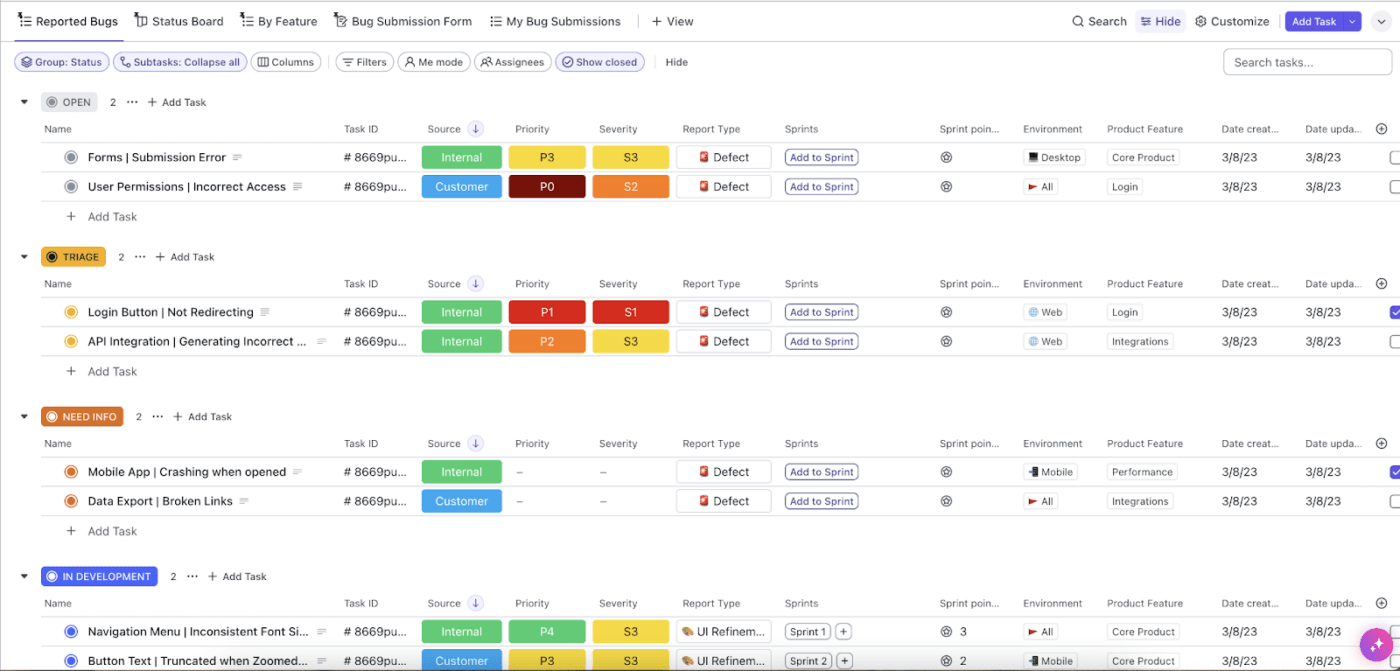
The framework centers on three roles: the Product Owner prioritizes features and maintains the backlog, the Scrum Master removes obstacles and facilitates meetings, and the Development Team delivers the work.
Each sprint follows a predictable rhythm. Sprint Planning sets goals, Daily Standups keep everyone synchronized, Sprint Reviews demonstrate completed work to stakeholders, and Sprint Retrospectives identify improvements for the next cycle.
Software teams use Scrum extensively for complex projects requiring frequent collaboration, but any creative or technical project with moving parts benefits from the structure.
The framework works best with teams of five to nine people because daily coordination becomes unwieldy with larger groups, and the daily check-ins prevent small issues from becoming major blockers before they derail progress.
Regular sprint reviews keep focus on what matters rather than what was originally planned, while the retrospective mechanism built into each sprint drives continuous improvement instead of repeating the same mistakes.
Cathay Pacific adopted the Nexus framework to improve the development of their Internet Booking Engine (IBE) project. They formed three focused teams and implemented regular reviews. The payoff? They went from releasing updates every three months to 2-3 times monthly. Passengers got a better experience faster, and the airline gained a competitive edge.
Kanban visualizes work items moving through stages on a board. Tasks appear as cards that progress through columns like “To Do,” “In Progress,” and “Done.”
The key difference from other methods is limiting work-in-progress to prevent bottlenecks and maintain quality.
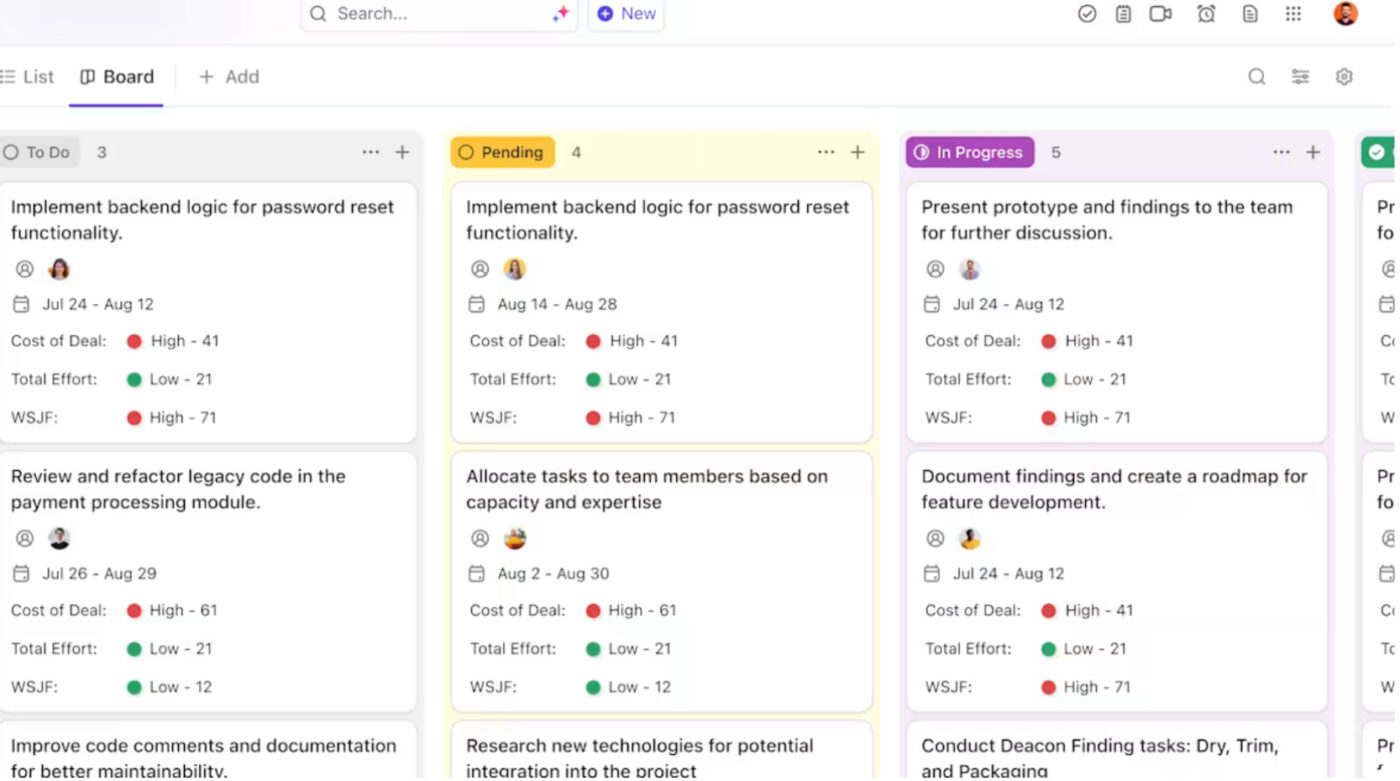
Work-in-progress limits prevent overload. Each column has a maximum number of items allowed simultaneously. When a column reaches its limit, team members cannot pull new work until something moves forward.
This constraint forces teams to finish what they started before taking on more, reducing context switching and improving completion rates.
Teams handling ongoing streams of requests rather than distinct projects benefit most from Kanban. Support teams managing tickets, maintenance crews handling requests, and content teams producing material all fit this continuous flow model.
The visual nature makes bottlenecks instantly visible so when cards pile up in one column, you know exactly where the constraint exists.
Microsoft’s XIT Sustaining Engineering team used Kanban to transform their performance, achieving a 230% increase in delivery rates and cutting lead times from 5.5 months to just 12 days.
They replaced monthly planning with weekly replenishment, limited work in progress, and streamlined communication to handle tasks efficiently.
Scrumban combines Scrum’s structured ceremonies with Kanban’s continuous flow.
Teams track work visually on a board with work-in-progress limits, but instead of committing to fixed sprint goals, they pull tasks as capacity allows while maintaining regular coordination through daily standups and retrospectives.
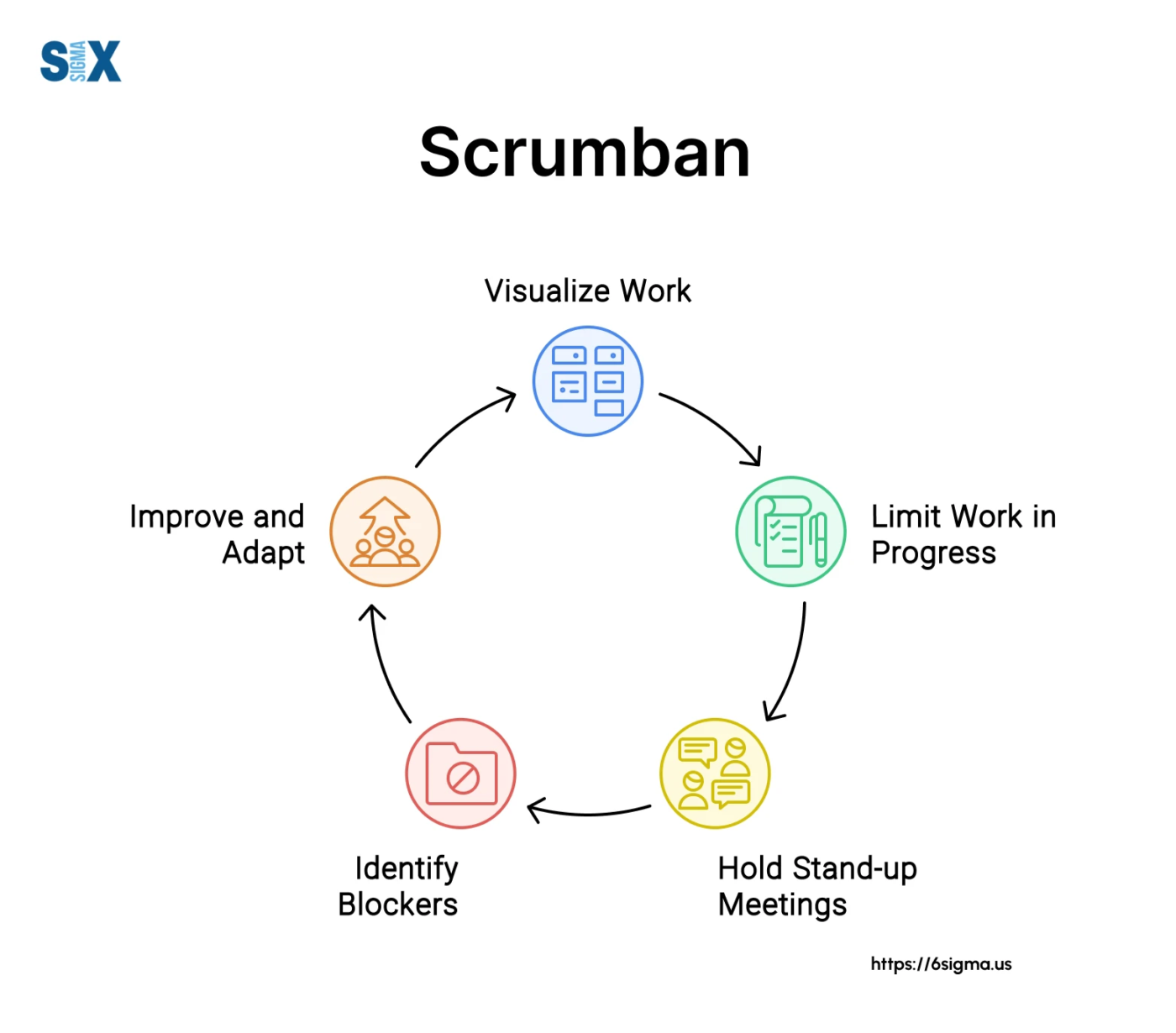
This hybrid approach works when teams need coordination without the rigidity of locked sprint commitments.
Software teams dealing with unpredictable workloads benefit from the balance, as do maintenance teams handling both planned projects and reactive support requests.
The visual board provides instant clarity on workflow and bottlenecks, while regular retrospectives preserve the continuous improvement mechanism that makes Scrum effective. Teams get structure to stay organized and flexibility to pivot when priorities shift.
They can adjust to changing requirements immediately without abandoning their coordination practices or waiting for the next sprint planning session, which helps them deliver consistently without feeling boxed in by arbitrary deadlines.
The House of Angular team switched from Scrum to Scrumban after constant priority shifts disrupted their sprint commitments.
They adopted flexible release cycles, clearer task statuses, and limited work-in-progress to one task per developer while keeping retrospectives between releases to identify improvements.
This hybrid approach let them adapt to client requests immediately while maintaining the coordination benefits of regular check-ins, improving both delivery speed and team morale.
Extreme Programming prioritizes technical excellence through practices like pair programming, test-driven development, and continuous integration.
Developers work in pairs where one writes code while the other reviews in real time, catching issues immediately rather than during later code reviews.
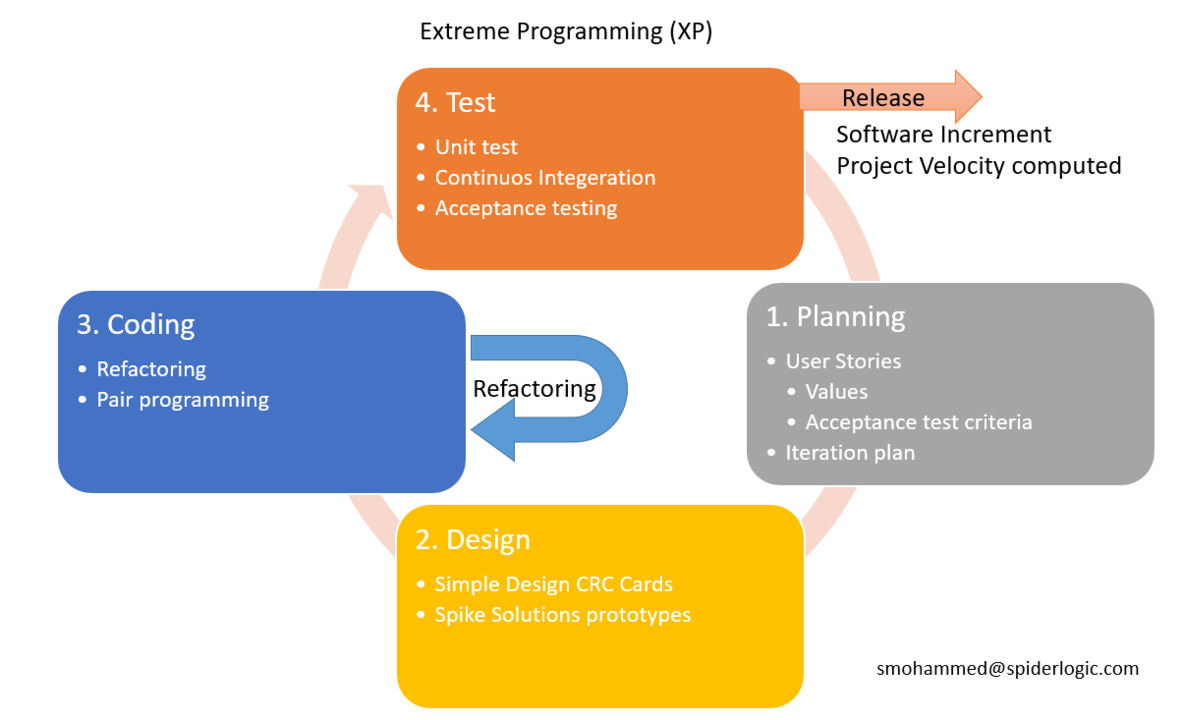
The methodology centers on writing automated tests before writing the code that passes those tests.
Teams integrate code changes multiple times daily to catch conflicts early, and small releases deliver value frequently, often weekly.
Customers work closely with the team throughout development to clarify requirements and provide feedback on working software rather than specifications.
Fast-paced software development environments where customer input and rapid changes are common fit XP well. Teams building complex systems that will evolve over years benefit from the disciplined practices because clean, well-tested code makes it easier to adapt as needs change.
The collaborative development approach catches issues early when they are cheap to fix rather than during user acceptance testing.
At Connextra, developers used XP to build ActiveAds, which displayed betting odds that updated in real time based on webpage content.
They followed short development cycles with constant client input, and pair programming ensured shared responsibility while catching integration issues immediately. When one bookmaker API changed its response format without notice, the developer’s pair spotted it during code review before it reached production.
XP’s focus on collaboration and rapid iteration helped the team dynamically display relevant betting odds in real time, meeting client needs efficiently.
Lean focuses on maximizing customer value while eliminating waste in processes. Waste includes unnecessary steps, waiting time, excess inventory, defects, and redundant effort that does not contribute to the final deliverable.

Teams start by mapping their value stream to visualize every step from start to finish. This reveals which activities create value for customers and which create waste.
The methodology then removes or reduces wasteful steps while creating flow by addressing bottlenecks. Work flows based on customer demand rather than schedules or quotas, preventing overproduction.
Manufacturing, product development, and operations management projects benefit most from Lean. Organizations with tight margins or capacity constraints see significant gains because small efficiency improvements compound into substantial cost savings over time.
Calgary’s postal plant Calgary’s postal plant faced declining mail volumes in 2023 and used Lean to identify waste in sorting processes.
Value stream mapping revealed workers walked an average of two miles per shift retrieving supplies, so the team reorganized the floor to position supplies at each workstation. This change alone cut processing time by 15%.
They then tackled waiting time—mail sat in bins between processing steps because downstream stations had different capacities.
By balancing station capacities and implementing a pull system, the plant freed 3.2 million square feet of space for consolidation, reduced lease costs by $4 million annually, and improved mail flow by 30%.
CPM identifies the longest sequence of dependent tasks that determines your project duration. Any delay in critical path tasks pushes back your entire completion date.
You start by mapping all tasks, their durations, and dependencies. Some tasks can run in parallel while others must follow sequences—you cannot install windows before framing walls.
The critical path is the longest chain from start to finish, and tasks on this path have zero slack time.

Complex projects with many task dependencies benefit from CPM. Construction, engineering, and infrastructure projects use this method extensively because timing is everything and tasks have clear predecessors.
Project managers focus resources on critical path tasks and look for ways to compress the schedule by adding resources or adjusting sequences.
In a hospital information system (HIS) project, CPM was used to keep everything on track, particularly for the outpatient registration subsystem.
The team identified Path 3 as the critical path, covering everything from demand analysis to system testing, which helped prioritize the most important steps.
They even managed to save 1000 yuan by compressing the subsystem test task from seven weeks to just four, all without sacrificing quality.
CCPM extends CPM by considering resource constraints and protecting the schedule with buffers rather than padding individual tasks.
Unlike CPM, which assumes resources are always available, CCPM identifies the critical chain—the longest path considering both task dependencies and resource availability.
If the same expert is needed for two parallel tasks, they cannot actually run in parallel.
Instead of padding each task duration for safety, CCPM removes that padding and consolidates it into buffers that protect the final deadline and critical chain from delays in non-critical paths.
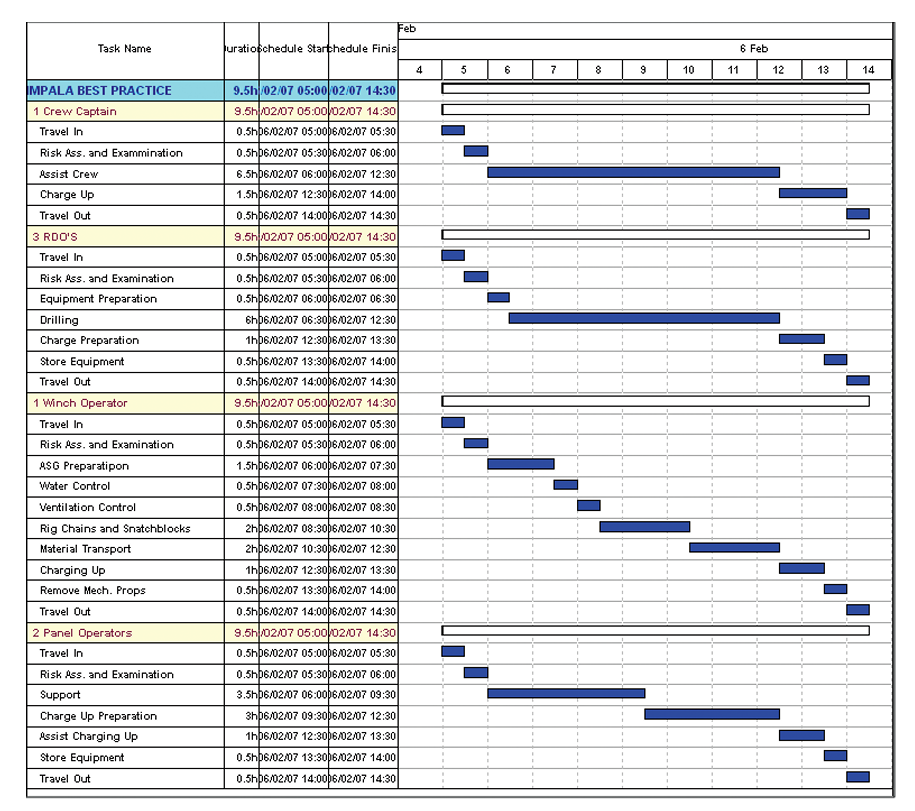
Manufacturing, product development, and R&D projects where resource conflicts create delays benefit from CCPM.
Teams monitor buffer consumption rather than individual task status:
This focuses attention on real schedule risks before they impact the timeline.
At Impala Platinum’s No. 12 shaft, applying CCPM gave a major boost to mining productivity.
The team tackled missed deadlines and budget overruns by managing resources more effectively, cutting down on multitasking, and using buffer strategies.
As a result, crews worked better together, stayed focused on shift goals, and handled risks more efficiently.
PRINCE2 (Projects in Controlled Environments) is a process-driven framework with defined roles, stages, and management products. It emphasizes business justification throughout the project.
The methodology divides projects into management stages with formal reviews at each boundary. Every project must have a clear business case that justifies continued investment at each stage.
Seven principles guide all projects: continued business justification, learn from experience, defined roles, manage by stages, manage by exception, focus on products, and tailor to suit the project.
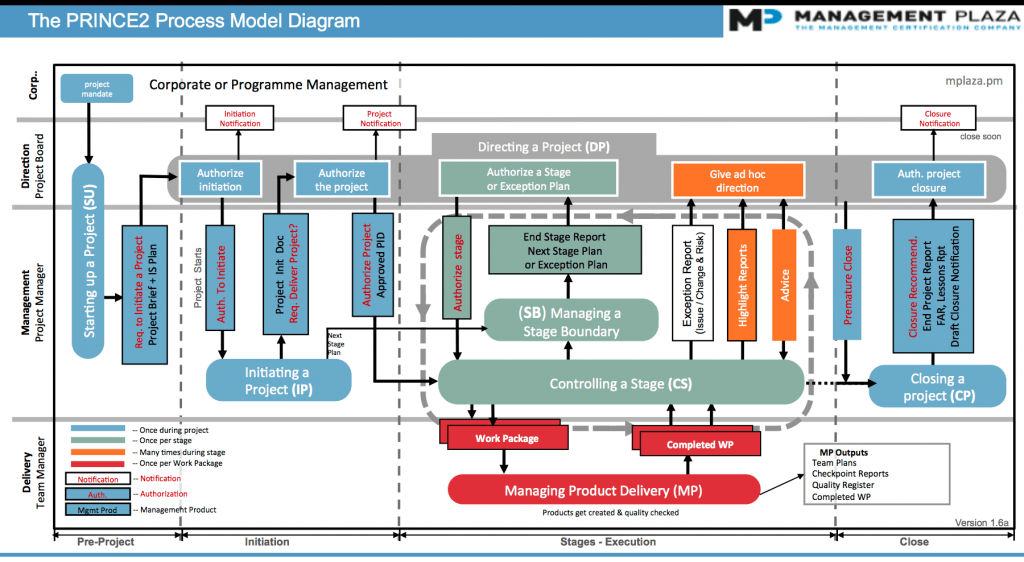
Government projects and large organizations, particularly in Europe, favor PRINCE2. Projects requiring strong governance and documentation fit this structured approach.
The framework carries significant overhead for small projects but provides comprehensive accountability for complex initiatives where multiple departments must coordinate.
Project management at the University of Western Australia Library used to be chaotic. Things changed in 2005 when the library adopted PRINCE2.
Staff received training, and the library began to see real improvements—projects got scoped correctly, planned, and executed.
As teams from different parts of the library worked together for the first time, unexpected cultural changes started to take place.
Six Sigma uses statistical methods to reduce defects and variation in processes, aiming for quality levels of 3.4 defects per million opportunities.
The DMAIC framework structures improvement projects:
Teams use statistical tools like process capability analysis, hypothesis testing, and control charts. Every decision requires data rather than intuition, and certified practitioners called Green Belts and Black Belts lead projects.
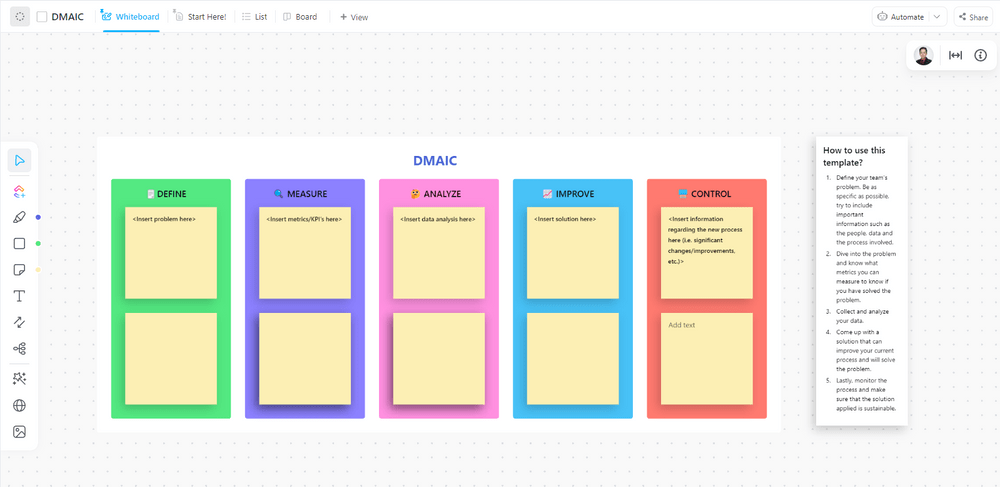
Manufacturing quality control projects fit Six Sigma perfectly, though service industries reducing errors in repetitive processes also benefit from the data-driven approach.
Any environment where defects are costly or dangerous matches this rigorous methodology, but the statistical tools require training and discipline while data collection and analysis slow project timelines.
The Texas Department of Licensing and Regulation (TDLR) faced rising costs and inefficiencies in managing its records.
In 2012, the agency launched a Six Sigma project to address these issues. The team reduced storage space, streamlined the retention schedule, and implemented automation to destroy expired records.
By 2017, the department slashed storage costs from $41,960 annually to $12,220, reducing boxes from over 6,000 to under 300.
⚙️ Bonus: Try Six Sigma templates to simplify process mapping, define clear goals, and track progress.
RAD prioritizes speed by building working prototypes quickly, gathering feedback, and iterating. The methodology sacrifices comprehensive documentation for rapid delivery.
Instead of lengthy requirements gathering, teams build a working prototype within days or weeks.

Stakeholders use the prototype and provide feedback on what works and what does not, then developers refine based on that feedback.
This cycle repeats until the prototype becomes production-ready, emphasizing reusable components and code generation tools to accelerate development.
Software projects with tight deadlines and engaged stakeholders fit RAD. Projects where requirements are unclear but time-to-market is critical match this approach, though it requires stakeholders who have time to review frequent iterations.
Documentation suffers because the focus is on working software over written specifications, and the emphasis on speed can create technical debt that slows future development.
A web mapping system was built using RAD to simplify land management for farmers. It helps track land ownership, monitor farmland status, and plan production needs, all while supporting precision agriculture.
Developers focused on quick feedback loops, working directly with farmers to refine features like spatial data integration and visualization. The iterative approach ensured the system was practical, user-friendly, and tailored to real-world needs.
APF assumes requirements are unclear initially and treats uncertainty as an advantage. The methodology adapts continuously based on learning rather than fighting ambiguity.

Teams plan just enough to start a short cycle, produce something tangible that stakeholders evaluate, then adjust direction before starting the next cycle based on what they learned.
The end goal may change as the team discovers what is possible and what customers actually need, so success means reaching the best possible outcome rather than meeting an original plan that may have been based on incorrect assumptions.
Research and development projects with uncertain outcomes fit APF, as do innovation initiatives where the solution emerges through experimentation.
The methodology requires stakeholders who accept that the end result may differ from initial expectations, while budget and timeline estimates remain imprecise because the path emerges over time rather than being predetermined.Retry
Kamikaze Software Systems had a tough time keeping smaller projects on track, especially with the growing number of change requests.
To fix this, they switched to APF, using iterative cycles and planning as they went. Involving clients directly in decision-making made a huge difference, helping them prioritize and tackle problems more effectively.
Outcome mapping tracks behavioral changes in key stakeholders rather than traditional project deliverables. Success means influencing how people act, not just completing tasks.
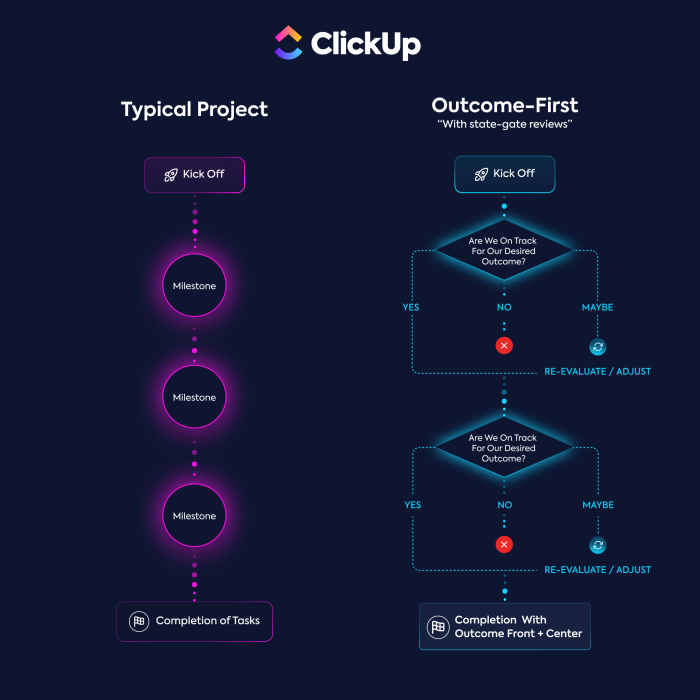
Teams identify boundary partners (the people or organizations whose behavior change will lead to desired outcomes) and monitor progress markers showing graduated changes in how they act:
Health, education, and community development organizations benefit from this approach when changing stakeholder behavior is the key to success.
The methodology puts learning first, helping teams measure complex, long-term changes while keeping stakeholders engaged through real-time updates.
It adapts when things change unexpectedly, making it effective for dynamic environments where traditional deliverable-focused metrics miss the actual impact.
NPI guides products from initial concept to market launch through systematic stages that align engineering, manufacturing, marketing, and sales teams toward shared goals.
The methodology moves through brainstorming ideas, developing concepts, testing prototypes with real users, and launching to market with coordinated support.
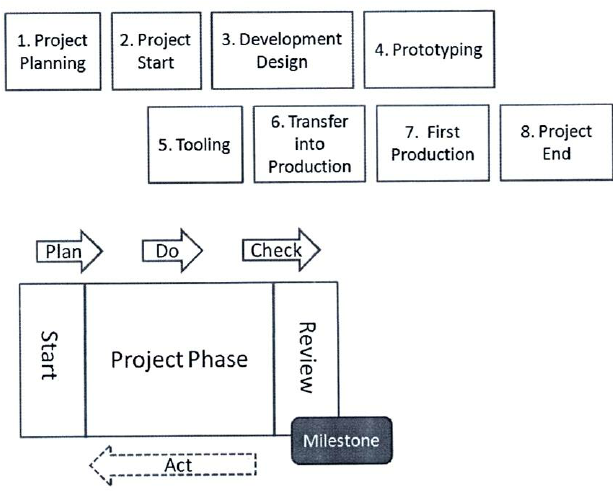
Involving all departments from the beginning prevents the classic problem where manufacturing discovers design issues too late or marketing promises features that engineering cannot deliver.
Electronics, automotive, and pharmaceutical companies where product failures are expensive and competition is fierce rely on NPI.
The structured approach catches potential problems early when they are cheaper to fix, while cross-functional involvement prevents departments from working in silos that create costly surprises during production ramp-up.
The PMBOK guide is a comprehensive framework providing guidelines, best practices, and standards for project management, published by the Project Management Institute.
The guide organizes project management into ten knowledge areas including scope, time, cost, and risk, then maps how they interact throughout the project lifecycle.
It provides a complete toolkit for planning, executing, and closing projects with emphasis on documentation and process that creates accountability.
Large, complex projects in construction, IT, and manufacturing where consistency and thoroughness are non-negotiable benefit from PMBOK.
The standardized approach ensures nothing important gets overlooked while helping teams speak the same project language across departments or organizations.
The comprehensive nature can feel heavy for smaller initiatives, though it helps teams recover quickly when things go off track.
TLC Family Care Healthplan’s initiative to streamline claims submission shows how the PMBOK Guide can drive project success.
The team established a clear framework through a dedicated Project Management Office (PMO), ensuring tasks were prioritized and risks addressed early. Regular meetings kept timelines on track, while quality checks improved accuracy and efficiency.
These efforts led to a 40% reduction in paper claims, saving over $15,000 annually and boosting provider satisfaction.
PER combines business process redesign with enterprise software implementation to create transformative improvements rather than automating existing inefficiencies.
The methodology requires rethinking workflows completely before implementing Enterprise Resource Planning systems. This ensures technology supports freshly optimized processes instead of just digitizing the same old inefficient workflows.
Combining process optimization with new technology delivers significantly greater improvements than using either approach in isolation.
Organizations going through digital transformation in retail, manufacturing, and healthcare benefit from PER, particularly when processes have grown organically over time and need a complete refresh.
Success requires willingness to challenge established workflows before investing in new systems rather than simply upgrading software tools.
Selecting the right methodology requires matching your project’s characteristics to each framework’s strengths. Follow this process to identify your best fit.
Begin by examining how stable your requirements are. If you can document everything upfront and changes will be expensive, structured approaches like Waterfall, PRINCE2, or CPM provide predictability. These work for physical products or regulated industries.
If requirements will evolve as you learn what users need, iterative methods like Agile, Scrum, or RAD adapt to change. You deliver working increments, gather feedback, then adjust for the next cycle.
For ongoing work without clear project boundaries, continuous flow methods like Kanban or Lean optimize throughput. Support teams, maintenance crews, and content producers benefit from these approaches.
Team size significantly impacts which methodology will succeed. Small teams of three to nine people thrive with Scrum or Kanban, which minimize coordination overhead and allow quick decisions.
Large organizations with dozens of contributors need defined roles and governance. PRINCE2 or PMBOK prevent miscommunication that plagues large teams. Cross-functional teams benefit from methods that make dependencies visible through regular ceremonies or visual boards.
Your timeline and budget flexibility determine how much planning you need upfront. Fixed deadlines and budgets require predictable scheduling through Waterfall, CPM, or PRINCE2, which front-load planning to identify risks early.
Flexible timelines and learning budgets allow Agile or APF to discover the right solution iteratively. Urgent projects needing rapid market entry suit RAD, which builds working prototypes in days rather than weeks.
Align your methodology with stakeholder engagement preferences.
Clients wanting frequent reviews and input fit Agile and Scrum’s sprint cadence. Those preferring detailed upfront planning with periodic milestone reviews match Waterfall and PRINCE2.
Internal projects with minimal oversight can use self-organizing approaches like Kanban or Lean.
Test your chosen methodology on a small project phase before full rollout. Run the pilot for one or two cycles, then gather feedback on whether it helped or hindered progress. Use this feedback to adjust your implementation before expanding to additional teams.
Work today is broken. Teams lose time switching between disconnected tools for tasks, docs, chat, and goals—slowing down execution and scattering knowledge.
Designed to replace multiple tools with a single, unified platform, the ClickUp Project Management Software helps teams tackle projects of any size and complexity. ClickUp is the everything app for work that brings project management, document collaboration, communication, and knowledge into one place—accelerated by AI at every layer.
ClickUp AI isn’t a bolt-on—it underlies every feature, from automation and intelligent search to real-time updates and workflow suggestions. This is the power of convergence: one platform, one source of truth, and one cohesive system built to help teams move faster and work smarter.
ClickUp is advanced enough to support power users and project management professionals, while flexible enough to allow users with fewer requirements to get the job done in the same tool, and the same space.
Let’s break down how ClickUp’s unique features help you tackle every stage of project management. 💪🏼
ClickUp makes organizing work effortless and collaborative.
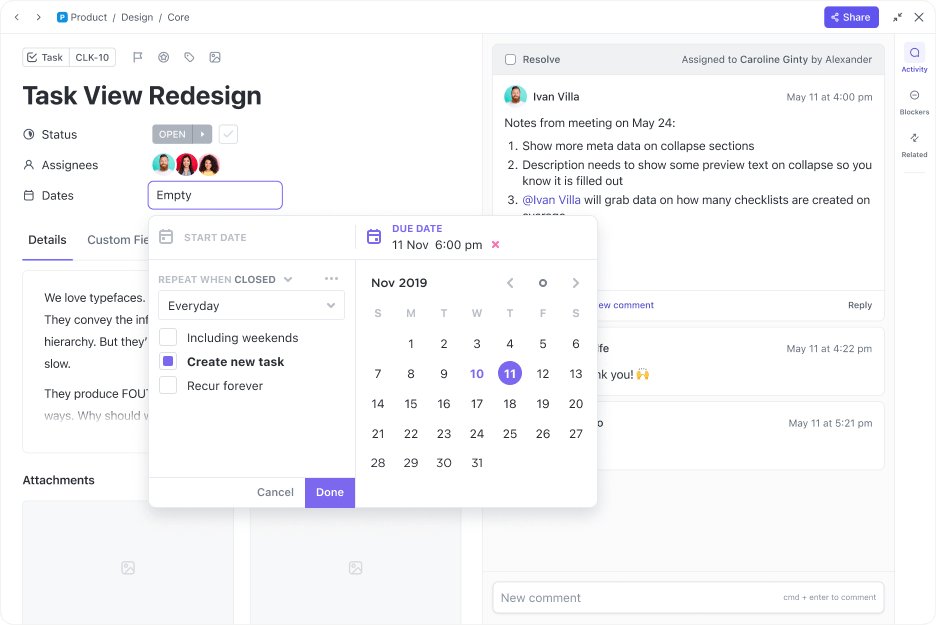
Start with ClickUp Tasks, the foundation of project management. This feature allows you to break down big projects into manageable steps, assign team members, set deadlines, and track progress in real time.
Each task can include detailed checklists, attachments, and comments, so you have everything you need in one place.

Then, with ClickUp Custom Fields, you can add specific data points like project phases, estimated hours, or task priorities to ensure every detail aligns with your goals.
This level of customization means your tasks are more than just to-do items—they become rich data points for better project visibility.
⚡️ In action: A marketing team handling a product launch can break tasks into ‘Content Strategy,’ ‘Design Assets,’ and ‘Ad Campaign Setup.’ Custom Fields like ‘Content Type’ (e.g., blog post, social media ad) and ‘Approval Status’ (e.g., pending, approved) help track progress and ensure smooth approvals.
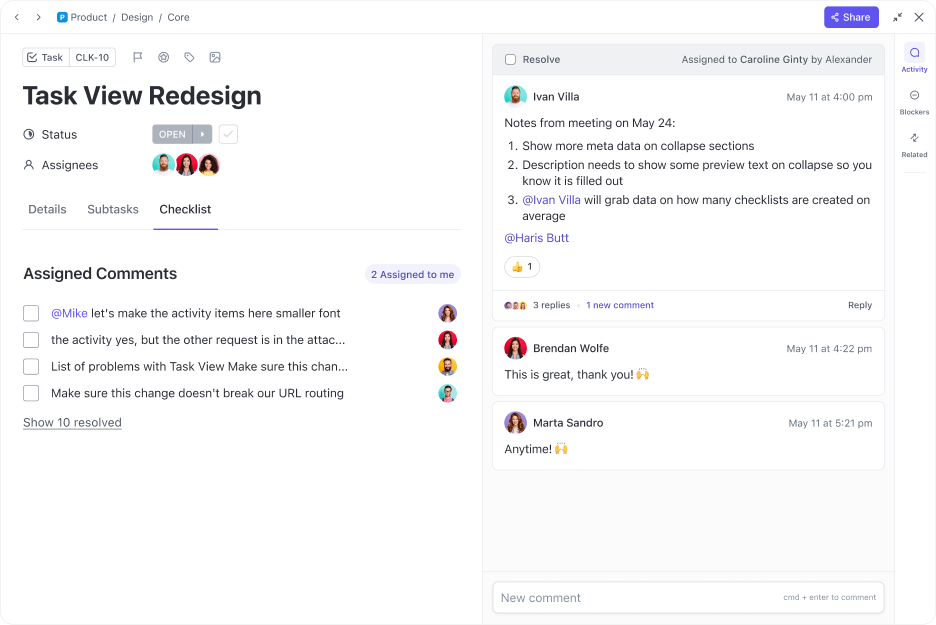
Finally, ClickUp Assign Comments ensures discussions don’t get lost in endless threads. Turn any comment into an actionable item and assign it to a team member directly.
🔍 Did You Know? The Burj Khalifa, the tallest building in the world, took six years to complete (2004-2010). The project succeeded thanks to meticulous scheduling and modular construction strategies. It’s often highlighted in project management courses for its innovative risk management.

ClickUp Time Tracking logs how much time each team member spends on a task, helping identify bottlenecks or tasks taking longer than expected.
Start the timer when you begin working on a task, pause it for breaks, and stop it when done. ClickUp automatically records this information, allowing you to compare estimated vs. actual time spent on tasks.
⚡️ In action: A software development team building a new feature can use Time Tracking to measure how long individual tasks like coding or QA testing take. If timelines are off track, they can adjust schedules and reallocate resources as needed.
🔍 Did You Know? 47% of respondents in Wellingtone’s State of Project Management research shared that professional project managers mostly or always run their projects. It goes to show how common it is to rely on experts to keep things organized and moving forward.
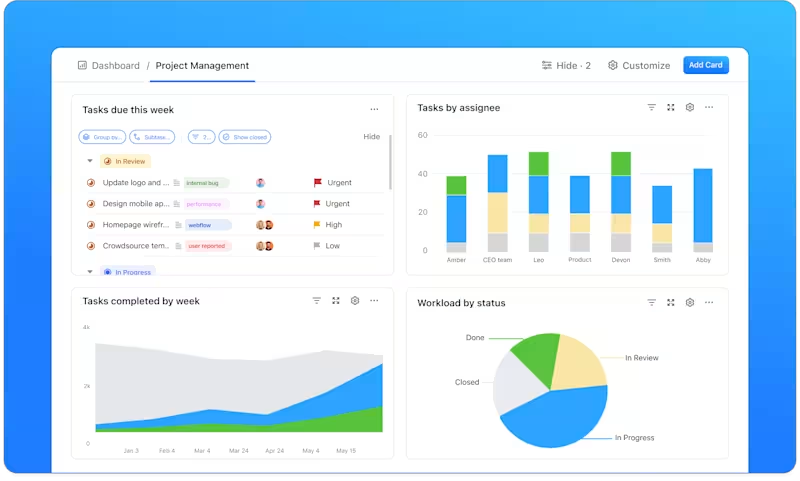
Having a single source of truth for your projects is critical, and that’s where ClickUp Dashboards come in.
Dashboards consolidate all your project data into one interactive, customizable space so you can monitor progress, team workload, and key metrics at a glance.
Cards like ‘Task Progress,’ ‘Team Workload,’ and ‘Burndown Charts’ make it easy to track what’s happening and spot potential issues. Dashboards update in real time, keeping everyone on the same page.
⚡️ In action: A marketing manager overseeing multiple campaigns can track overdue tasks, team bandwidth, and campaign performance—all on one dashboard. This eliminates the need for back-and-forth emails or scattered spreadsheets.

Different methodologies often call for specific visualization tools. ClickUp Views match your workflow. For example:
Without ClickUp, we wouldn’t be able to quickly see gaps in work and process. Being able to see tasks without due dates, overdue tasks, and tasks without sprint points or assignees helps me keep forward momentum.
Flexibility is a key advantage of ClickUp.
You can switch between Kanban, Gantt, Calendar, and other views in a click. Each view adapts seamlessly to match the team’s working style or the project’s requirements, eliminating the need for external tools.
🧠 Fun Fact: Henry Gantt introduced the Gantt chart in the 1910s, revolutionizing how projects are visualized. Surprisingly, these charts were initially used for shipbuilding during World War I.
ClickUp also brings all your tools together. Over 1,000 ClickUp Integrations connect it to apps like Google Drive and Zoom, creating a unified space for collaboration.
It’s also time for you to meet ClickUp Chat.
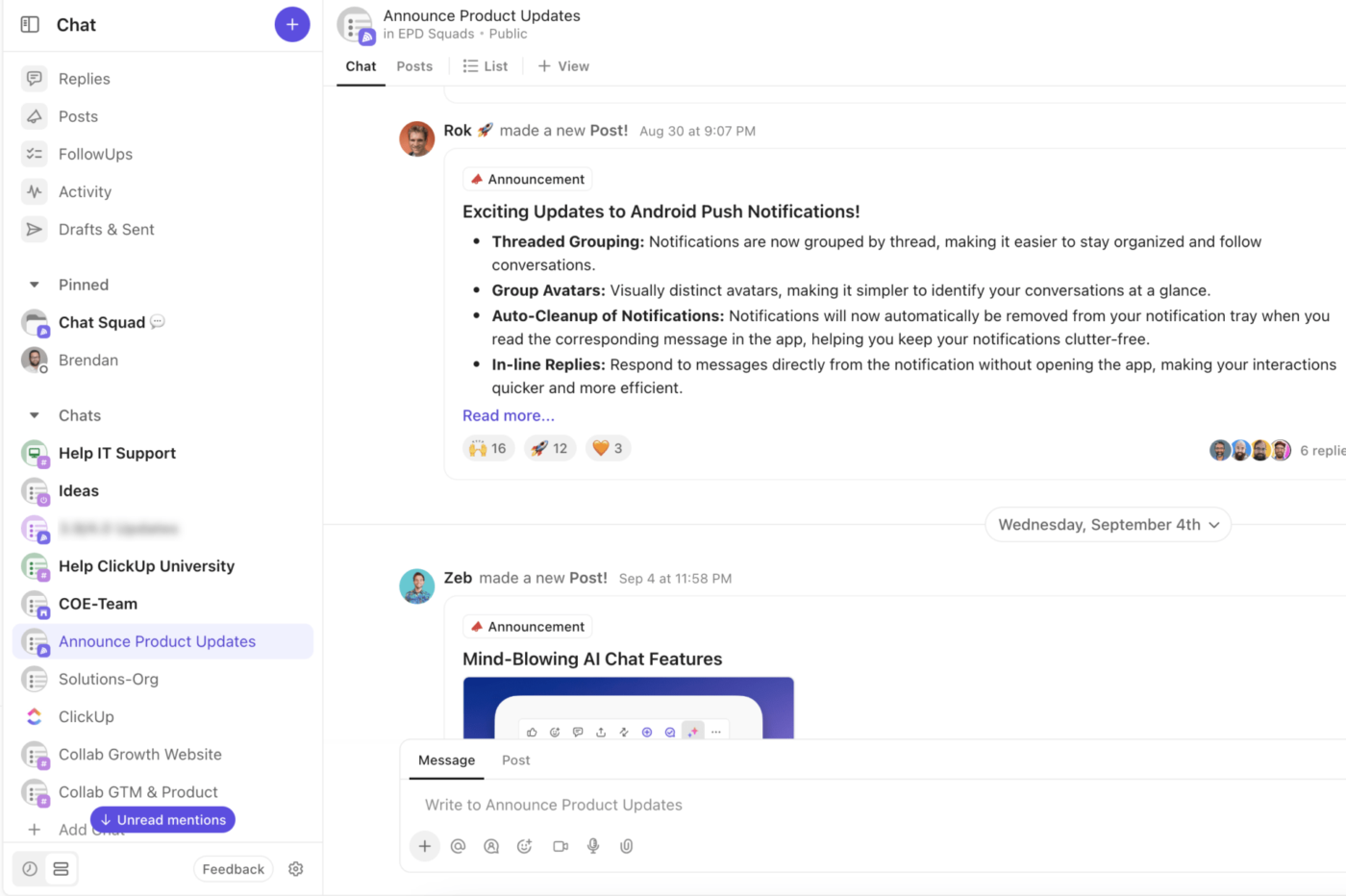
Chat isn’t just another messaging tool. It’s designed to simplify communication and bridge the gap between conversations and tasks.
No more scattered updates or missed follow-ups—everything stays in one place, making collaboration smooth and stress-free.
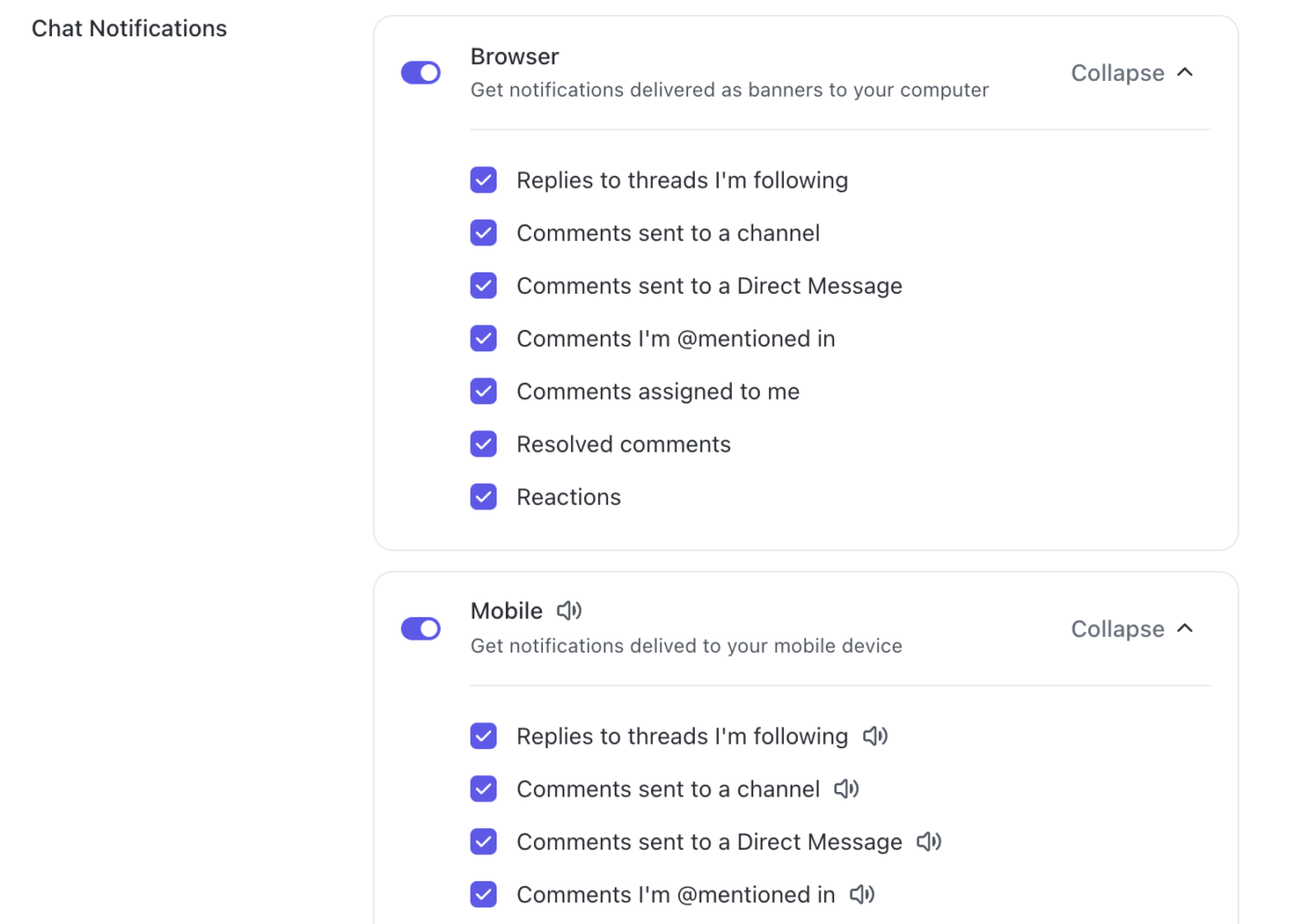
Custom notifications keep distractions at bay, allowing you to focus on important conversations without being overwhelmed by unnecessary updates.
For instance, you can prioritize threads relevant to your role while silencing less critical discussions. And when it comes to follow-ups, assigning responsibilities directly within Chat ensures tasks move forward smoothly.
Did You Know? According to PMI, the average project performance rate across respondents is 73.8%. Industries approach project management differently, with financial services leading in agile adoption (58%) and construction favoring predictive methods (76%). Hybrid approaches are popular in information technology (55%), healthcare (53%), and financial services (53%).
VMware, a leader in multi-cloud services, transformed its operations and boosted efficiency by 8X using ClickUp. Before this, scattered project requests across emails and Slack caused delays and messy handoffs.
ClickUp brought everything together in one place, automating busy work, speeding up project intake, and standardizing workflows with templates.
This shift saved VMware 95% of the time spent building QBR assets and gave leadership clear visibility with Dashboards for smarter decision-making.
Managing projects can feel overwhelming, but choosing the right methodology makes all the difference. Whether it’s Agile, Scrum, or Waterfall, the right approach helps your team stay organized, on track, and ready to adapt to any challenges.
But even the best methodologies need a powerful tool to support them. ClickUp is built to handle any project, with features like task management, real-time dashboards, and customizable workflows that make your work easier and more efficient.
Why wait? Sign up for ClickUp today!
📌Try this first
Before you explore the 17 project management methodologies, why not see them in action?
Use ClickUp’s Free Project Management Template to streamline planning, organize tasks, and apply any methodology—right out of the box.
© 2025 ClickUp